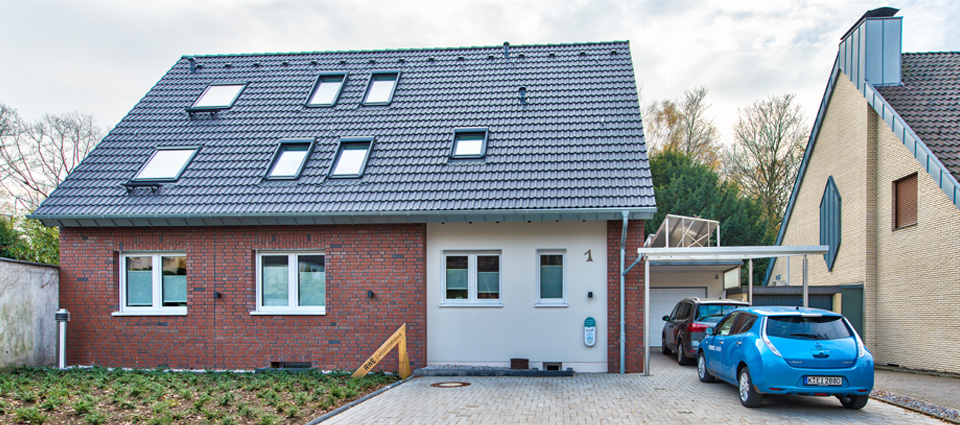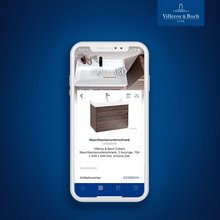From the suburban home to a showpiece
The RWE Future House in Bottrop

The conversion of a single-family home in need of renovation into a future-oriented Plus-Energy House corresponding to the standard of 2013 is an exemplary undertaking. The comprehensive renovation into an energy-efficient building is the result of a publicity campaign and enjoys the support of renowned project partners. Sanitary facilities from Villeroy & Boch have been perfectly integrated into the concept for sustainability and environmentally compatible technology characterising the new RWE Future House in Bottrop.
At first glance, the freestanding house belonging to the Kewitsch family looks like a typical building from the 1960s: gable roof, brick facade, carport, and front garden. These external features also suggest conventional equipment, and for 50 years this was also the case. However, during a time in which every building carries its own energy card and awareness for energy-efficient living and construction has increased enormously, it may be worthwhile to take another look behind the facade.
The conversion of the old building into a showcase for modern plug energy construction took place in the scope of the 'InnovationCity Ruhr | Modellstadt Bottrop'. It is a city development project in which various individual campaigns and measures should bring about an environmentally-conscious conversion of the city while its status as an industrial location is safeguarded. The four-member Kewitsch family, who lives in the pilot area, won an open competition in 2012 to have their old building in need of renovation converted into a future house. In the 'single-family and two-family house' category, the project was managed by RWE Effizienz GmbH and implemented with the help of products from numerous renowned manufacturers from the construction industry.
A metamorphosis which pays off
The comprehensive conversion measures on the previously humble residence lasted for a year. The concept of a plus energy house entails a significant reduction of energy consumption with insulation and the use of environmentally-compatible technologies, as well as the local extraction of energy, wherein a positive balance can result. The Kewitsch family home is especially suitable for this purpose, because it has a large roof surface area for the installation of a solar system. However, changes to the existing equipment had to take place first. The brick facing work, terrace coverings and railings were removed, the roof tiles, battens, and dormers were removed, old windows and doors, air conditioning and heating equipment had to make way for new products. The house received both a new core and a new shell in the truest sense while maintaining an almost identical appearance. Skylights in the roof and three-glass window systems corresponding to the passive house standard now provided the exterior effect. Interior insulation and vacuum insulation were provided in the bath, on the terrace, and basement ceiling. The exterior insulation was provided with a 30-cm-thick thermal insulation composite system and the exterior stucco and brick apron were used as visible facade parts The roof, which was prefabricated with multiple insulating layers, supports a photovoltaic system with modules precisely matching the dimensions of the skylights. With an area of 60 square metres, the system, which should generate 8,000 kilowatt hours of electricity per year takes up almost the entire roof surface. The windows have a sensor system which provides protection from heat by means of automatic shading and which automatically close when it rains.
Intelligent building technology down to the smallest details
A brine/water heat pump system was chosen for efficient heating technology and a solar thermal system for the garage roof serves in an supporting role. The rooms are provided with a space-saving floor heating system, which is only four centimetres high, and ceiling heating on the upper floor. The extensive LED lighting makes an important contribution to the reduced power consumption. Finally, the house has intelligent networking via RWE SmartHome: the technical equipment, roller shutters, lights, and all household appliances can be controlled via mobile. The sanitary facilities form Villeroy & Boch make an additional important contribution to the environmentally-compatible building technology. This includes the water-saving AQUAREDUCT system, by means of which the WCs of the SUBWAY 2.0 collection only use 3 or 4.5 litres of water with the same flushing capacity. With the easy-to-clean Quaryl surface of the SQUARO SUPERFLAT shower, cleaners and water consumption can be reduced, whereby the overall concept of sustainability is incorporated down to the last detail.
Looking ahead
After a year, the residents and the project initiators took stock and came away with entirely positive results. The heating and power consumption were reduced by 99 per cent, and now the renovated house has nearly reached its goal of a positive energy balance. The family is thrilled by the new comfort and safety, as well as the savings on energy and building maintenance.
Along with cutting CO2 emissions in the model city Bottrop, improved quality of life is one of the explicit aims of the project InnovationCity Ruhr. This goal has certainly been achieved for the Kewitsch family and it might even have even been demonstrated that a future house may some day be lurking behind every brick facade with gable roof.





